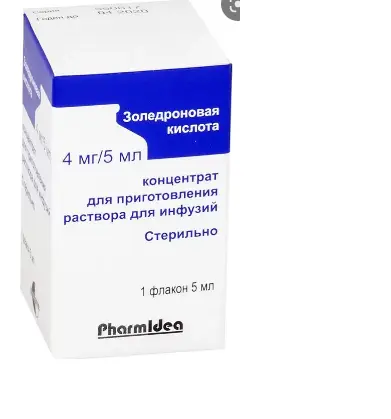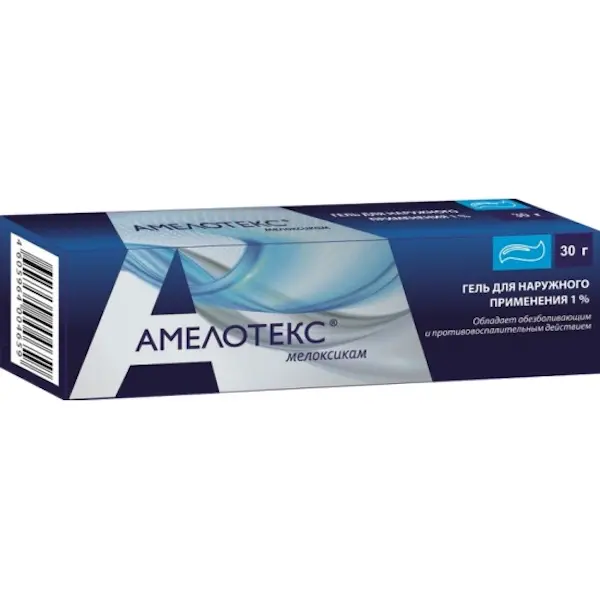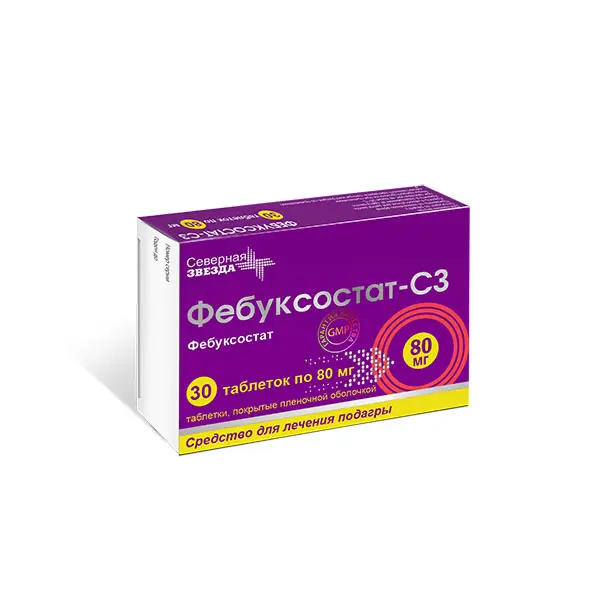Description
Zoledronic acid Pharmacodynamics
Zoledronic acid belongs to highly effective bisphosphonates, which selectively act on bone. The drug suppresses bone resorption by acting on osteoclasts.
The selective action of bisphosphonates on the bone tissue is based on the high affinity for the mineralized bone tissue. The exact molecular mechanism providing inhibition of osteoclast activity is still unclear. Zoledronic acid has no undesirable effect on bone formation, mineralization and mechanical properties.
In addition to its inhibitory effect on bone resorption, zoledronic acid has antitumor properties, which ensures the effectiveness of the drug in bone metastases:
In vivo: inhibition of osteoclastic bone resorption, altering the bone marrow microenvironment, resulting in reduced tumor cell growth; anti-angiogenic activity. Suppression of bone resorption is clinically accompanied by a pronounced reduction of pain sensations.
In vitro: inhibition of osteoblast proliferation, direct cytostatic and pro-apoptical activity, synergistic cytostatic effect with antitumor drugs; anti-adhesive/invasive activity.
Zoledronic acid, by inhibiting proliferation and inducing apoptosis, has a direct antitumor effect against human myeloma and breast cancer cells, and also reduces penetration of human breast cancer cells through the extracellular matrix, which indicates that it has antimetastatic properties. Besides, zoledronic acid inhibits proliferation of human endothelial cells and has anti-angiogenic effect in animals.
In patients with breast cancer, prostate cancer and other solid tumors with metastatic lesions of bones zoledronic acid prevents the development of pathological fractures, spinal cord compression, reduces the need for radiation therapy and surgery, reduces tumor hypercalcemia. The drug is able to inhibit the progression of pain syndrome. The therapeutic effect is less pronounced in patients with osteoblastic foci than in osteolytic ones.
In patients with multiple myeloma and breast cancer with at least one bone focus, the efficacy of zoledronic acid at a dose of 4 mg is comparable to pamidronate at a dose of 90 mg.
In patients with tumor hypercalcemia the effect of zoledronic acid is characterized by a decrease in serum calcium levels and renal calcium excretion. The average time to normalization of calcium levels is about 4 days. By day 10, calcium concentrations normalize in 87-88% of patients. The average time to relapse (albumin-corrected serum calcium level of at least 2.9 mmol/L) is 30-40 days. There are no significant differences between the efficacy of zoledronic acid at doses of 4 and 8 mg in the treatment of hypercalcemia.
Studies show no significant differences in the frequency and severity of adverse events observed in patients treated with zoledronic acid at doses of 4 mg and 8 mg, pamidronate at a dose of 90 mg, or placebo for both the treatment of bone metastases and hypercalcemia.
Indications
Bone metastases in malignant solid tumors (prostate cancer, breast cancer and others) and multiple myeloma, including to reduce the risk of pathological fractures, spinal cord compression.
Hypercalcemia (albumin-adjusted serum calcium concentration ≥12 mg/dL or 3 mmol/L) due to malignancies.
Contraindications .
Hypersensitivity to zoledronic acid, other bisphosphonates or any other component of the drug.
Severe renal dysfunction (CKG less than 30 ml/min).
Pregnancy and breast-feeding period.
Childhood (effectiveness and safety have not been established).
Caution:
Use the drug with caution in patients with renal dysfunction of mild to moderate severity (CKR > 30 ml/min).
Caution should be exercised when concomitant use with other drugs that may cause hypocalcemia (e.g., aminoglycosides, calcitonin, “loop” diuretics) due to the risk of synergistic effect leading to severe hypocalcemia.
The drug should be used with caution concomitantly with other drugs with nephrotoxic potential.
Caution should be exercised when using concomitantly with antiangiogenic drugs due to increased risk of osteonecrosis of the jaw.
Caution should be exercised when using in patients with severe hepatic dysfunction due to limited data on the use of the drug in patients of this category.
Pregnancy and lactation:
The use of Zoledronic Acid during pregnancy is contraindicated.
The drug Zoledronic acid may have adverse effects on the fetus. Toxic effects on reproductive function were found in animal studies. There are no data on the use of the drug during pregnancy in humans.
If pregnancy occurs during therapy with bisphosphonates, there may be a risk of intrauterine fetal malformations (e.g., skeletal and other abnormalities). The dependence of risk on the amount of time between discontinuation of bisphosphonate therapy and conception, the route of administration, and the characteristics of the specific drug is unknown.
Women of reproductive age should be warned about the need to use reliable methods of contraception during treatment with Zoledronic acid.
It is unknown whether zoledronic acid penetrates into the breast milk. The use of Zoledronic acid during breastfeeding is contraindicated.
In animal studies, zoledronic acid suppressed fertility at a dose of 0.1 mg/kg per day. There are no data on the effect of zoledronic acid on fertility in humans.
Dosage and administration
- Bone metastases in malignant solid tumors and multiple myeloma:
- Adults and elderly patients.
- The recommended dose is 4 mg by intravenous drip for at least 15 minutes every 3-4 weeks. Before administering the drug, dilute the concentrate (contents of 1 vial) with 100 ml of calcium-free infusion solution (0.9% sodium chloride solution or 5% dextrose solution).
- Patients should also be prescribed additional calcium orally at a dose of 500 mg per day and vitamin D orally at a dose of 400 ME per day.
- Hypercalcemia due to malignant tumors:
- Adults and elderly patients
For hypercalcemia (albumin-adjusted serum calcium concentration ≥12 mg/dL or 3 mmol/L), the recommended once-daily dose of the drug is 4 mg. In order to ensure adequate hydration of the patient, administration of saline is recommended before, simultaneously or after infusion of zoledronic acid. - Patients with impaired renal function
Hypercalcemia due to malignant tumors:
The decision to treat with zoledronic acid in patients with significant renal dysfunction should be made only after careful evaluation of the risks of the drug and the expected benefits of therapy. Patients whose serum creatinine concentration is < 400 µmol/L or < 4.5 mg/dL do not require dosing adjustments. - Bone metastases of advanced malignancies and multiple myeloma:
The dose of zoledronic acid depends on baseline creatinine clearance calculated by the Cockcroft-Gault formula. It is not recommended to take zoledronic acid in patients with severe renal impairment (creatinine clearance values <30 ml/min). - After initiation of therapy, serum creatinine concentration should be determined before each dose of the drug. If renal function abnormalities are detected, the next injection of zoledronic acid should be postponed. Renal dysfunction is determined by the following parameters:
- For patients with normal baseline serum creatinine concentration (<1.4 mg/dL), a 0.5 mg/dL increase in creatinine concentration;
- For patients with an altered baseline serum creatinine concentration (>1.4 mg/dL), an increase in creatinine concentration of 1 mg/dL.
- Zoledronic acid therapy should be resumed only after creatinine levels reach values within ±10% of the initial value, at the same dose used before treatment interruption.
- Preparation of the infusion solution
From 4 mg/5 ml concentrate (contents of 1 vial) a solution for infusion is prepared under aseptic conditions. Before administering the drug, the concentrate (contents of 1 vial or less, if required) is diluted with 100 ml of calcium-free solution for infusion (0.9% sodium chloride solution or 5% dextrose solution). Prepared zoledronic acid solution should preferably be used immediately after preparation. Unused solution can be stored in aseptic conditions in refrigerator at +2-8 ° C for no more than 24 hours. Before injection the solution should be kept indoors until it reaches room temperature. - Total time between dilution of the concentrate, storage of the solution under aseptic conditions in refrigerator at +2-8 °c and the end of the drug administration shall not exceed 24 hours.
- Zoledronic acid solution should not be mixed with any other drugs. The drug should not be mixed with any solutions containing calcium and any other divalent cations, such as Ringer’s solution. A separate infusion system should always be used for the administration of zoledronic acid solution.





